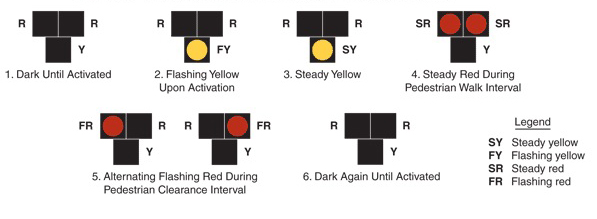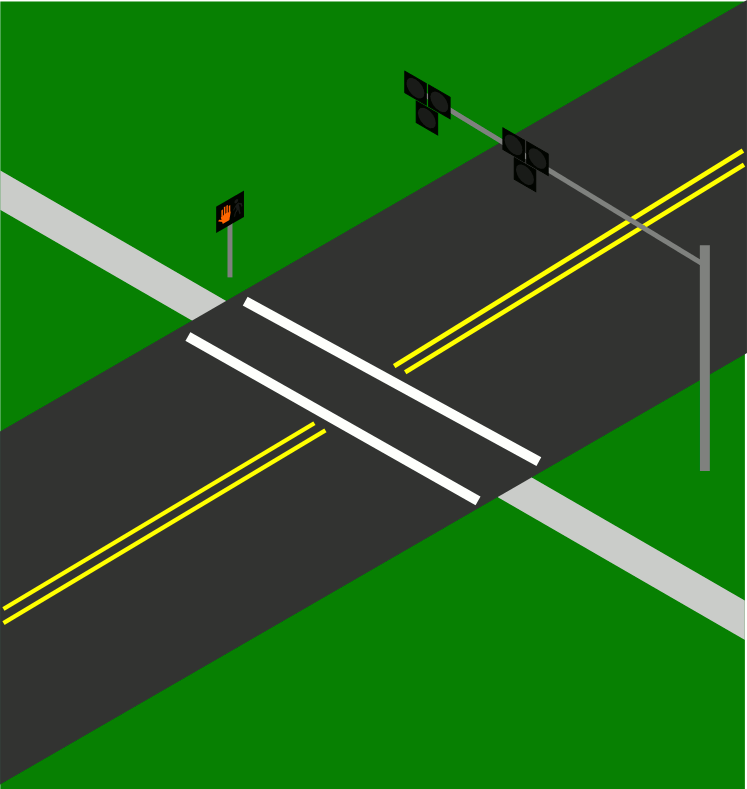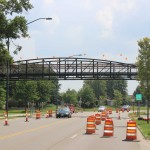In late June 2014, the Delaware County Engineer’s Office activated the first HAWK signal in Central Ohio. This High-Intensity Activated Crosswalk (HAWK) signal is located on Big Walnut Road near Galena. This type of crossing is officially known as a Pedestrian Hybrid Beacon or PHB.
Prior to this installation, there was no signal or crosswalk at this intersection. Approximately 5,100 cars travel Big Walnut Road on a daily basis and the intersection is on the route to Walnut Creek Elementary from the large residential neighborhood to the south. A normal traffic signal did not meet the design requirements.
After a Feasibility Study, the installation of a PHB signal was recommended. Carpenter Marty Transportation completed the design of this signal. Funding for this project was received through the Safe Routes to School Program (SRTS). The SRTS Program is a federally funded program that encourages walking and biking to school as a way to improve the health of students by increasing physical activity and decreasing some of the side effects of vehicular transportation such as increased traffic and emissions. The project also included the installation of new school zone signage near the signal and bicycle racks at two elementary schools in the district.
 The PHB signal operates only when activated by a pedestrian who wishes to cross. Once the pushbutton is activated, the signal sequence is started, first with flashing yellow, then steady yellow, and finally steady red over a short period shown to traffic. The pedestrian signal head display will remain the red upraised hand (don’t walk) until the signal displays the steady red signal, at which time the pedestrian head displays the white walking person indication (walk). The “don’t walk” pedestrian signal head will begin to flash when typical pedestrians no longer have enough time to cross before the signal releases traffic back to normal operation. At the same time as the flashing “don’t walk” for pedestrians, the signal displays flashing red lights to traffic indicating operation equivalent to that of a stop sign. During this phase, vehicles must stop at the signal, but may proceed after yielding to pedestrians in the crosswalk. The PHB signal goes dark and a steady “don’t walk” will appear for pedestrians until the signal is once again activated by pressing the pushbutton.
The PHB signal operates only when activated by a pedestrian who wishes to cross. Once the pushbutton is activated, the signal sequence is started, first with flashing yellow, then steady yellow, and finally steady red over a short period shown to traffic. The pedestrian signal head display will remain the red upraised hand (don’t walk) until the signal displays the steady red signal, at which time the pedestrian head displays the white walking person indication (walk). The “don’t walk” pedestrian signal head will begin to flash when typical pedestrians no longer have enough time to cross before the signal releases traffic back to normal operation. At the same time as the flashing “don’t walk” for pedestrians, the signal displays flashing red lights to traffic indicating operation equivalent to that of a stop sign. During this phase, vehicles must stop at the signal, but may proceed after yielding to pedestrians in the crosswalk. The PHB signal goes dark and a steady “don’t walk” will appear for pedestrians until the signal is once again activated by pressing the pushbutton.
According to the Federal Highway Administration, vehicle/pedestrian crashes can be expected to be reduced by as much as 70% after the installation of a PHB signal.

“HAWK Optimized” by KJBurns – Own work. Licensed under Creative Commons Attribution-Share Alike 3.0 via Wikimedia Commons




2 thoughts on “Central Ohio’s First HAWK Signal”
Rush Bludworth
January 4, 2015 at 1:57 amIt really is an excellent project. I am grateful that you contributed to this intersection to improve the safety of our kids.
Gene Houlding
March 24, 2015 at 3:18 pmAwesome article.
Comments are closed.